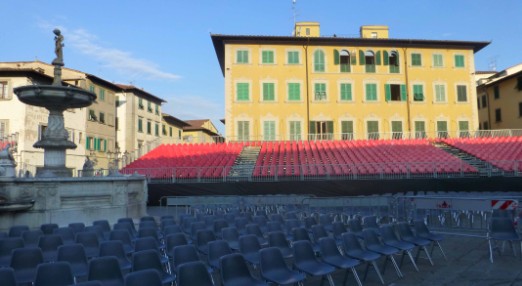INTRODUCTION
Prato is now the second largest town in Tuscany, and at the same time the nearest to Florence. Even though a few other Tuscan towns may have had a greater relevance in the past, the history of Prato is certainly worth of a particular attention.
This is also true in the limited sector in which we are interested here: card games in the 19th century. As a matter of fact, the Tuscan towns that by then could establish academies at the town level are not many, and Prato is one of them.
This note reports the result of a specific investigation. It can be divided into two parts. The first part summarises the history of the private associations that took pleasure in card playing. The second part provides further detail on selected aspects or times, on the basis of documents first studied from this point of view.
It must be noted that the selection is not the result of a previous project, which could set the limits and the main objects of the study, but just reflects the situation encountered in the documents that have been kept.
1. GENERAL INFORMATION
1.1 A schematic outline of the entertainment organisation in Tuscany
Prato is a suitable place for studying the evolution of entertainment and pastimes among the citizens and their social relevance. This is especially due to its middle dimensions: in Florence the situation was too complex and many associations were active; in smaller towns, only some aspects could be present.
In order to recognise the situation we can simply examine it on the basis of several dualities in contrast. Actually, considering the antagonistic elements operating, and their evolution, is a useful tool for understanding. This is obviously a schematic approach, in which we just examine the black and white points, neglecting all the intermediate grey tones that certainly were present together.
A duality can first be seen between noblemen and middle-class persons - of course the lower classes had their own pastimes too, but at the time we never meet them in the places under study. Usually, it was a task of the nobles to establish a common house, instead of using their own family mansions, as before, in order to have a suitable meeting place for parties, celebrations, dances, welcome receptions for visiting personages.
This common house was usually indicated as Casino dei Nobili. With the improvement of the social and economic conditions of the middle class, it occurred that they decided to establish a similar house, in which they could enjoy the same or comparable pastimes as the nobles. The regular evolution, in agreement with the times, was that the second-born institution increased in importance in the town, up to possibly include the remaining parts of the first.
Another duality concerned which kind of entertainment should be preferred. At the beginning, more important were literature, poetry, and scholar discussions on science and philosophy. This aspect slowly declined in favour of bare leisure, as offered by dances and game playing.
Apart from this distinction between black and white aspects, it is not possible to neglect which was then probably the most relevant “grey” activity, theatre, the best method to satisfy the needs both of the men of letters and of those who mainly looked for amusement.
Another duality existed with secular and clergy members. Priests and abbots were not so few as we might imagine. Precisely in Prato, at a given time, the statutes of the main academy required the same number of secular and clergy members in the managing council.
The evolution of the activities was on its turn depending on two contrasting trends: on the one hand, entertainment was extending its influence, in agreement with what was occurring in other similarly or even more “developed” towns in Tuscany and abroad. On the other hand, some rulers of Tuscany, either belonging to the last Medici, or to the Lorraine-Hapsburg House, were rather bigoted and especially inclined to set severe limits not only to gambling, but also to playing, dancing, and so on.
The complex interactions between the elements mentioned has been studied for Tuscany by several historians, and particularly by Addobbati for the 18th century. Let me refer to his book for corresponding detail, and examples.(1)
1.2 Historical development of academies and clubs in Prato
As in Florence and in other Tuscan towns, the habit of companies of nobles and scholars to meet for conversation and performances flourished in Prato since the Renaissance. A significant fraction of the members were priests, on the average more cultivated in the liberal arts, to begin with some knowledge of the Latin language and literature.
In the middle of the 16th century there was in Prato the academy of Addiaccio, led by Agnolo Firenzuola. Then they had simultaneously the Floridi and the Allorini academies, with a more distinguished participation of the noblemen in the former.
In 1712, the only active academy there was the Accademia dei Semplici, established in 1617 and frequented by the nobles. In that year, a new academy was founded, the Accademia degli Infecondi, in order to allow the middle-class to participate in similar activities.
Semplici was not the name corresponding to simple, but was intended as herbs (as in Giardino dei Semplici), with some suggestion of sprouts and growth. As a contrast, Infecondi or infertile was a correspondent pejorative attribute, as often occurred at the time in these cases, possibly understandable as a sign of humility – clearly more alleged than real.
The interests of the members were various and of a rather different kind - fundamental was the Filodrammatica, amateur dramatic society, and this aspect was often explicitly mentioned in the name itself of the academy.
However, writing and performing original tragedies and comedies was not the only occupation: the literary activity was extended to the composition of poems, celebrations, scholarly discussions on the most disparate subjects.
A different aspect involved the organisation of parties and dances: this occurred at fixed dates, but any further suitable occasion was looked for. There was also an ordinary activity of playing, which was possible during all the days and evenings (except for holy days), and which is the aspect that has been less studied by our historians.
Clearly, keeping all the different aspects alive could disclose contrasting elements. Some of these contrasts were more compatible at the time. In particular, one contrast that sometimes has been indicated by the historians is that between the sacred and the profane. Money spent in playing cards recorded between sums offered in the many forms of charity and church activities used at the time may appear in some disagreement now, but this was then the rule.
One has to remember that a significant part of the members belonged to the clergy. This cannot be surprising in Prato, if one just notes that the leading figure at the foundation itself of the Accademia degli Infecondi, and during the compilation of its statutes, was Giuseppe Bianchini, a parish priest, who also gave lectures at the renowned Accademia della Crusca in Florence.
Nevertheless, the leisure aspect, which developed later, soon became prevalent, and a section of the Accademia degli Infecondi became better known as Casino dei Cittadini – this was then, since 1721, the main part of the academy. A similar evolution had occurred with Casino dei Nobili, derived from the Accademia dei Semplici.
1.3 Palazzo Dragoni
Using the documents now kept in the Archivio di Stato di Prato (ASPo), a short history of the Accademia degli Infecondi was read and published in 1912 for celebrating its bicentenary.(2) This has been the basis of the subsequent studies dealing with this academy, including one that extends the description to later times.(3)
Later on, the present study may be extended to include the developments occurred in the 19th century. For the moment, however, let me just mention that in 1830 the Academy moved into the Casino dei Gentiluomini in Via de’ Banchi (thus making evident the merging of the two institutions, with that deserved to noblemen having lost most of its influence), and that in 1862 it changed its name into Società dei Misoduli, which continued its activity till 1997.
In the 18th century, in which we are interested here, the location for the meetings of the academy was Palazzo Dragoni, in Piazza del Duomo, directly in front of the Duomo’s façade, with the celebrated Cantoria sculpted by Donatello on its right edge.
This location was thus not only a prestigious palace, but offered an extraordinary view on the main place of Prato – a situation that was exploited during the periodic celebrations and parades that were organised in the place itself, to begin with Calcio games.
The windows on the first floor were then offered to the most important local or visiting personages, whereas the academics observed the events from the windows on the second floor. In particular, a visit of the Grand Duke and his family in 1768 brought about so heavy expenses for works, repairs, and decorations, that seriously affected the balance and the solidity itself of the academy.
1.4 List of the Prato documents
The only document that I could find up to now from the Accademia dei Semplici is a thin folder in the Archivio di Stato di Firenze (ASF).(4) In a previous note,(5) it is possible to find a short description of the ASF and the corresponding references.
The few documents kept are essentially related to some performances and expenses connected with them. However, a receipt for the purchase of a Trucco, with all its equipment, in 1705, and a list of incomes from Trucco, Pallottole, and Carte in 1713 are a clear proof that games were played there too. (Trucco and Pallottole are quoted in other notes, but Carte in just this one list.)
Much more successful is our search for Accademia degli Infecondi. Coming from it, and from the following Società dei Misoduli, a remarkable group of thirty books and registers have been kept in the ASPo.(6) Again, a short description of the ASPo with the corresponding references can be read in a previous note.(7)
The following list of the items of the 19th century is taken from the inventory present in the ASPo, in agreement with that published by Pampaloni.(8)

2. DISCUSSION OF THE DOCUMENTS
The nine documents from the Infecondi archive, which come from the 18th century, can clearly be divided into two different groups: five books or folders with various documents, four account books. Let us examine them in some detail.
2.1 Documents and corresponding information on activity and members
No. 1, “Libbro delle Costituzioni”, contains the initial statutes of the Academy, established in 1712, and the main subsequent versions, of the years 1763, 1800, 1808, 1817, and 1829. The last item is a booklet printed, bound together with the previous handwritten items. Of course, a detailed study of the differences among these copies could provide some useful insight into the life of the academy. (I only focused my attention on a special point in the text of 1800, see below.)
No. 2 is a folder with five files, which correspond to the same or a very similar version of a project for a new constitution of the Association. It does not contain various proposals coming from different times, as the indication in the inventory might have suggested (and especially nothing as old as the 17th century). An accurate study should provide a narrow interval of possible dates.
No. 3 is a hardbound book containing 270 folios of 21x31 cm. It appears to be the most important document of them all, because it keeps the minutes of all the yearly meetings of the society for almost a whole century. Apparently, it has been largely used by the authors of texts on the academy, to begin with Caprin.(2)
Often the report is very concise, but sometimes, and especially when extraordinary events had occurred in that year, we can read several pages reporting and commenting on the activity. A further advantage of this book is that its handwriting is usually easy to read.
No. 10 seems to be a kind of appendix to the main books. It is a large and thick hardbound book, consisting however of loose sheets stitched together: here we find, in no less than 494 folios, notes, reports, letters, receipts, inventories, mainly for the first years of the 19th century.
No. 28 is a precious list of all the members of the Academy. It is an index note book (cardboard cover, 21x31 cm), with pages cut on the right edge at various heights for the different letters of the alphabet, and cut moreover on the top, in order not to repeat the heading of the three columns at each page.
The first column has the family names, the second the year of admission, the third for any additional indication. In particular, in correspondence with the year 1712, we find in the third column that the given person was one of the founding members. If I counted them correctly, they were no less than 64, a rather remarkable amount, even if compared with the sixty members required by some of the statutes.
2.2 Membership and visitors
Thorough information on the members of the academy can of course be deduced from register No. 28. The order is here mixed: alphabetical, because individual pages correspond to increasing initial letters of the family names; chronological, because every member’s name is added as soon as accepted in the academy. Of course, this system does not allow us to determine the number of members at various times, because no name is deleted, in correspondence to deaths or resignations.
As usual in similar associations in other towns at the time, there were much more participants to the various activities of the Academy than their members. It may be interesting to understand which were the people, who were admitted into the rooms. Of course, the family members of the academics, to begin with. Who else could obtain the status of permanent visitor? Anybody could apply for being accepted, but the admission was subject to an approval by the council.
Several conditions were required, more or less obvious: to be known as a person with a moral rectitude, willing to behave correctly in the society. Once ascertained that to enter this Academy one did not need to belong to the nobility, we might suppose that anybody could be accepted.
Actually, cases could occur in which the responsible or the council felt embarrassment to deny the acceptance. Therefore, some general rules and conditions were approved, in order to provide an easier screen of the applicants.
It is evident that the access was only available to the middle-class: the conditions were indeed rather strict: one had to be a citizen of Prato, living in the town; all peasants were thus excluded straightaway.
Moreover, the status and the profession of the citizens could not be low. In the corresponding chapter in the files of folder No. 2 a long list of professions is present, which immediately excluded the participation in the activity of the academy. Practically, all artisans were thus not admitted, together with most retailers, simple civic servants, not to mention shop boys.
Conditions were also set for visitors coming from elsewhere: they could only be accepted if introduced by a member, who was personally responsible for the identification and behaviour of the visitor.
2.3 The account books
Curiously enough, four different names have been used in the inventory for the four account books kept together. This is in part justified by their contents.
No. 18 can reasonably be indicated as a notebook. It appears only to contain notes and receipts for the theatre and the organisation of performances. We are not interested in this sector now, and the documentation is moreover poor - let us neglect this information.
The three remaining books have instead much in common, to begin with some handwritings and the vellum paper covers. It seems that No. 22 and No. 19 are the main ledgers: the first has 248 numbered folios, 23x34 cm, with expenses recorded from f.104 to f.204, and the remaining left blank; the second has all 143 folios written, 22x30 cm.
The journal No. 17, almost 70 unnumbered folios, 21x29 cm, had instead been used as a cash journal with immediate recording. The two ledgers, which I have mostly used, have separate sections for incomes and expenses, whereas they are distinguished in the journal by using two adjacent columns at the right edge of the page.
2.4 Packs of playing cards acquired, from book No. 22
The quantitative information that I could collect from register No. 22 on card packs acquired by the academy is summarised in the table below. As in similar cases, greater amounts of packs may be reached with a more carefully examination of the original records.
A real problem for obtaining the totality of the items involved is that in several cases the amount of packs is not indicated and they appear together with other goods, such as oil and candles, without distinguishing the individual contributions to the purchase.
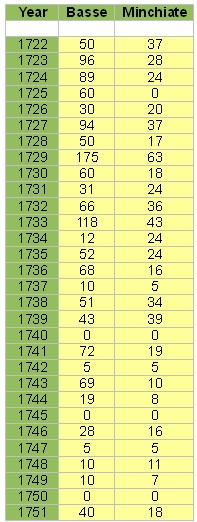
I have added here the contributions for each year in the table, but all the individual entries found have been copied in the appendix. In principle, we could expect approximately the same consumption of cards through the years, or some slow increment or decrease of them. Actually, a general decrease can be observed in the background of these amounts, but there are remarkable oscillation, with some values significantly distant from an average value.
It is hard to ascertain if these oscillations were real or are mainly the result of missing records in my lists. Maybe even harder is to explain why we observe these differences, if real. This may be possible just in individual cases: for instance, the small 12 packs of 1734 may be due to packs still available from the 118 of the previous year.
These numbers are not reliable enough to support a serious statistical processing. My hope is that somebody continues this kind of research, ultimately obtaining more complete results. There is however one result, which I consider reliable enough: the high fraction of Minchiate in comparison with the packs of Carte basse.
If we examine the ratio of Minchiate to the total packs through the years, we still find some strong oscillation about an average value of almost 30%, but in this case the situation is more convincing and can be taken as a proof that Minchiate still were a very popular game in that milieu.
2.5 Packs of playing cards acquired, from book No. 19
Further data can be deduced for the second half of the century, from register No. 19. If the quantitative information of the previous register was not fully reliable, in this case the situation is even worse. For many years, it is impossible to give the amount of card packs purchased by the academy. Moreover, the reasons for the missing data may be various.
Most common is the case in which the cards prices are cumulated together with those for candles, oil, or other items, without any distinction, and without mentioning the quantity of the card packs. The data missing after 1773 may be easier to explain with the “terrible” law of that year against card playing in the whole of Tuscany.
For some years, the expense for a whole year is provided instead of recording the individual purchases of playing cards. Typically we read that on 30 April of a given year the manager or the keeper are refunded for their expenses of the previous twelve months. This could be useful for us, because having a direct information on the yearly consumption is simple and enough for our aims. However, this yearly refund is in some cases given in parts, to different persons, which somewhat complicates the situation.
The following table is a tentative reconstruction of the counts, with the simplification that I used here for indicating the dates: from 1 May of the previous year to 30 April of the given year.
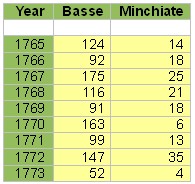
In some cases, I have apparently missed some contribution, but we can nevertheless derive some general conclusion for these years too, as follows.
The amounts of card packs acquired per year is about 100 for cards and 15 for Minchiate, with the latter corresponding to around 13%. In comparison with the previous time interval, almost a double quantity of cards is used, which clearly shows that the practice of card playing had increased in the meantime. As could be expected, playing Minchiate was instead suffering a small decrease, even if the contribution remained significant.
The records that I could find after 1773 are not enough to allow a similar table of the yearly amounts to be derived. A few scattered records have been copied in the appendix. It is possible to deduce something from them only with the help of independent information and some imagination.
After the terrible blow connected with the law of 1773 some years had been necessary to introduce card playing again in the academy, reportedly near the end of the century. By then, the amount of packs acquired was reduced, and Minchiate continued to show a decreasing trend of popularity, arriving at about 10 per cent of the cards used.
The value of 10% is low in comparison with that of several decades earlier on, but is of the same order of magnitude as found at the time in Florence itself, and may thus be considered as greater than reasonably could have been expected.
2.6 Licences for card playing in Prato
Two official registers are kept in the ASF, with the lists of all the licences given to clubs and shops for allowing to play, beginning with 1744.(9) This was the only permitted way to play, and one had to pay a tax for it. There were various levels of taxation, according to the games allowed.
The yearly tax could thus be of 3 Scudi for Trucco and board games. Even for cards, there were distinctions, with Minchiate having for some years the smallest tax of 4 Scudi to pay. Most usual was the tax of 6 Scudi, which included using Carte basse for traditional games.
The highest tax was that of 20 Scudi and allowed Bambara (a game of the Primiera family, often associated with it) among the card games that could be played. The fact that it was paid by several houses in Tuscany clearly shows that the practice of betting games had many fans, even if strongly opposed.
On the other hand, real bank games, and Bassetta and Faraone in particular, had been strongly forbidden everywhere, and more than once, in previous times.
As for Accademia degli Infecondi, we are fortunate enough, because we can find the corresponding money amounts recorded both in the registers of the academy kept in Prato, and in the official registers of the ASF. The usual tax was in this case that of 6 Scudi, but in the registers in the ASF we find payments as low as 2 Scudi for a half-year tax for just Minchiate up to 24 Scudi in a couple of years around 1760, apparently allowing Bambara too.
The payment in Florence of 6 Scudi by Francesco Franca, the keeper of the academy, we find sometimes recorded as L.46 s.2 in the registers in Prato. Considering the correspondence of 7 Liras for 1 Scudo, the bare tax was of L.42, but s.2 were added for the receipt, and L.4 for the travel expenses.
One may be interested in checking which other places were active in Prato, and which tax they paid for the licence. Actually, other places existed, in which play was allowed, more than we could imagine.
Not surprisingly, barbers’ shops were active in this field, following a tradition that had lasted for centuries. Domenico and Arturo Bini barbers Al Canto alla Fortuna we first find in August 1745 with the usual tax of 6 Scudi, but more often they paid the yearly 20 Scudi in later years. In 1747 another barber, Giovanni Maria Martinazzi, Alla Fonte di Piazza, paid 6 Scudi.
Probably barbers were also several persons, who apparently took over the activity in the same shop in Banchi, Antonio Fiascaini, Giovan Battista Lolli, Francesco Falaboni, and Agapito Calosi. They usually paid the 6 Scudi tax. (I am not believing that this could correspond to the Casino dei Nobili, but in any case was placed near to it.)
Other shops were involved, for which the main activity is not mentioned. The first to be recorded is Francesco Marchesuoli, in Via dei Sarti, with taxes of 20 or 6 Scudi, depending on the years. In this case his Stanze or rooms are cited, in addition to his shop.
Finally we find Giovanni and Giuseppe Sartini, in a place rather unpredictable: Bottega dirimpetto al palazzo di Giustizia.
Probably, in later years some of these did no longer apply for the licences, whereas newcomers could appear, up to 1773. What we can now be certain is that, in all these cases, it will be hard to find documents or cash books kept for us to study.
2.7 Card games played in the academy
The information gathered on the playing cards used in Prato in the 19th century is not complete, but at the same time is quantitative enough, in a measure unknown before. What about the card games, in which these playing cards were used?
For Minchiate, the answer can be easy: they were used for playing the game of Minchiate. Essentially, this is a sufficient information. More delicate is the association of Carte basse with the games played with them.
Just for an interesting example, there is the international card game of Casino or Cassino, which has sometimes been reported as deriving its name from the Tuscan (or, maybe better, Florentine) Casino, where it was first learnt by foreign visitors. In Italy we know our variant of this game as Scopa, but no early evidence has still be found of its initial spread.(10)
Now, in book No.1 an exceptional information is provided. It is contained in the part of the book, which is dated 1800, thus the very last year that can be considered to belong to the 19th century under investigation here. It probably echoes, however, previous rules of the academy.
The aim of this rule was not that of listing the games played there. Important was to distinguish these games from gambling ones, and this could essentially occur on the basis of the highest stakes admitted to the players. As a matter of fact, it was necessary, in order to obtain the licence to play cards, that not only the games belonged to the allowed ones, but also that they were not played for big amounts of money.
I have compiled the following table on the basis of the 1800 statutes of the academy, Chapter XX. Of course, what we are the most interested in is precisely the detail in the kind of games played, instead of the corresponding limits in the stakes.
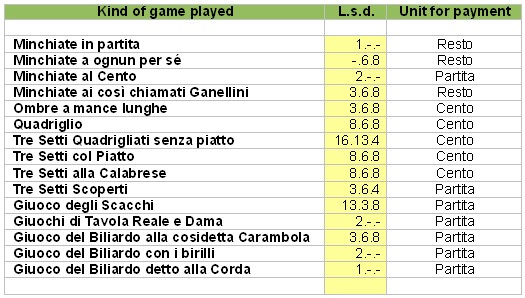
I had never seen such a detail in these few games. To begin with, there are no less than four variants of Minchiate listed at the beginning, more than could be expected at the time. Rather unexpected as well is to find here the variation of Ganellini, which we commonly find mentioned in Genoa - with a Florentine origin easy to suggest for both cases.
As for the games played with Carte basse, the list begins with Ombre, a name that has nothing to do with it usual meaning of shadows, but is just the Italian spelling for the renowned Spanish game of Hombre. It could be played in its original form among three players, or as Quadriglio, its more recent form played four-handed.
It could be expected that several forms of Tressette were already popular, as they have remained in Tuscany for many decades later on.
Remarkable is on the other hand the presence here of the main board games, chess of course, but also draughts and Tavola reale, a kind of early backgammon. Three variants of billiards close the list, before a final statement, which requires that a copy of this list should be displayed on a wall of the academy.
CONCLUSION
The organisation of card playing in Prato in the 19th century occurred in a way rather typical for the Tuscan main towns. Little information has been obtained on Accademia dei Semplici, attended by noblemen, but some useful detail has been reported on the Accademia degli Infecondi, located in Palazzo Dragoni, in front of the Duomo.
With a few exceptions, card playing was an important part of the activity of the academy. Somewhat surprising is that the practice of Minchiate was still enjoying a wide popularity, to the point that Minchiate packs represented more than 20% of the playing cards purchased by the academy in the first half of the century and kept a remarkable 10% even at its end.
Brief information has been provided on other places, in which card games could be played in Prato at the time. On the other hand, a detailed list of the end of the century has provided new information on the typical card games played, and their variants.
Footnotes:
(1) Andrea Addobbati, La festa e il gioco nella Toscana del Settecento. Pisa 2002.
(2) Giulio Caprin, Dagli Infecondi ai Misoduli. Breve storia di un’accademia pratese. Prato 1912.
(3) Aldo Ciampolini, Prato Storia e Arte, 22 (1968) 89-103.
(4) ASF, Libri di commercio e di famiglie, No. 7.
(5) Franco Pratesi: 1451 – ONE COMMON PACK OF TRIONFI (2012)
(6) Archivio di Stato in Prato: ACCADEMIA DEGLI INFECONDI
poi SOCIETÀ DEI MISODULI
(7) Franco Pratesi: 1429/30 - NAIBI TRADED IN PRATO BY A NOTARY (2012)
(8) Guido Pampaloni, Archivio Storico Pratese, 35 (1959) 49-50.
(9) ASF, Camera e auditore fiscale, No. 3017 and No. 3018.
(10) Franco Pratesi, The Playing-Card, 24 No. 1 (1995) 6-12.
|
Once a place
for
Playing Cards
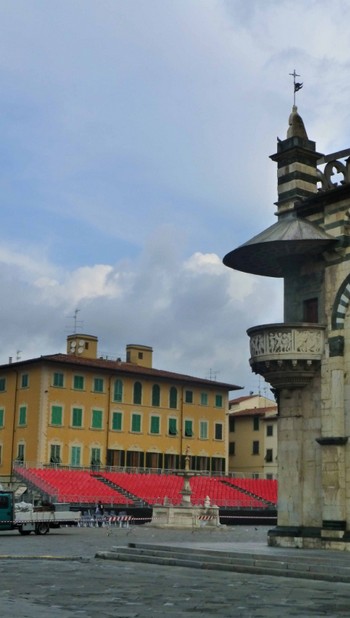
Palazzo Dragoni
with Donatello's "Cantoria"
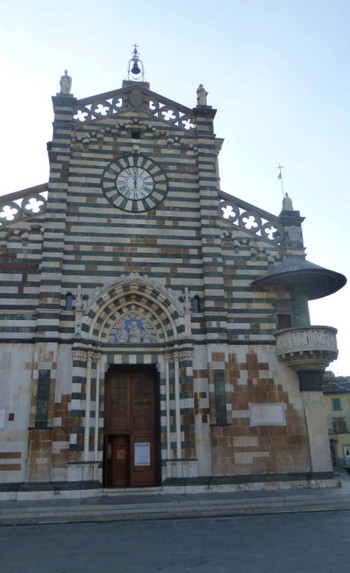
Duomo of Prato
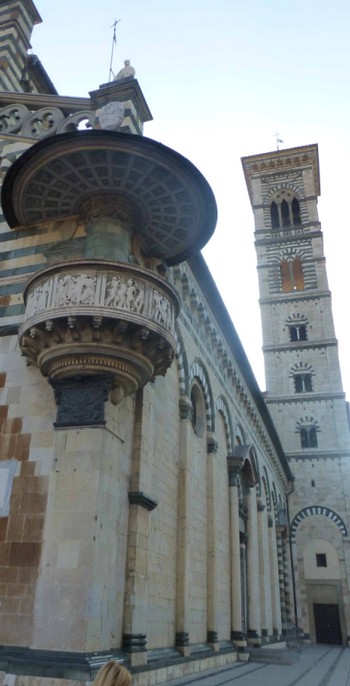
Cantoria
|
|




